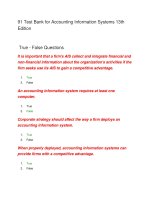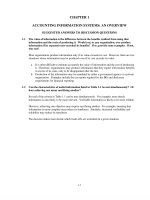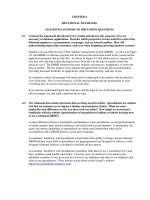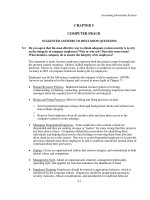Test bank core concepts of accounting information systems, 13th edition, by simkin, rose, and norman ch1
Bạn đang xem bản rút gọn của tài liệu. Xem và tải ngay bản đầy đủ của tài liệu tại đây (93.98 KB, 12 trang )
Core Concepts of Accounting Information Systems, 13th Edition, by Simkin, Rose, and Norman
Chapter 1
ACCOUNTING INFORMATION SYSTEMS AND THE ACCOUNTANT
True-False Questions
1.
The acronym AIS stands for “Accounting Information Standards.”
2.
Accounting information systems must be computerized to be effective.
3.
It is best to view an AIS as an accounting system that must be computerized.
4.
AISs often create information that is useful to non-accountants.
5.
In order to be useful, raw accounting data must be processed by a computer.
6.
The path that data follow in an AIS, for example from manual source document to
completed output report, is called an audit trail.
7.
A company's audit trail is normally easier to follow under a manual data processing
system compared to a computerized information processing system.
8.
The starting point for an audit trail of a payroll system might be an employee time card.
9.
The starting point for an audit trail of a production department might be the purchase of
raw materials.
10.
The acronym ERP stands for “electronic reporting plan.”
11.
The term information overload refers to providing too much data to management, often
resulting in managers ignoring it.
12.
An advantage of computerized AISs is that they do not need to be programmed to catch
simple input errors such as entering “4.0” instead of “40.0” for hours worked in a payroll
application.
13.
Computers tend to make audit trails easier to follow because everything is computerized.
14.
The acronym ERP stands for “enterprise reporting system.”
15.
The authors consider accountants to be “knowledge workers.”
16.
Predictive analytics use large data warehouses to help organizations improve
performance.
TB 1.1
Core Concepts of Accounting Information Systems, 13th Edition, by Simkin, Rose, and Norman
17.
As used in this chapter, the acronym SAR stands for “suspicious accounting reports.”
18.
Sections of the Patriot Act mandate suspicious activity reporting.
19.
One of the motivations for SAR is to identify money laundering activities.
20.
The term “Patriot” is an acronym for “providing appropriate tools required to intercept
and obstruct terrorism.”
21.
Section 352 of the Patriot Act requires auditors to verify that their organizations have
adequate risk assessment systems.
22.
Accounting systems are useful for performing accounting tasks, but cannot be used for
such security purposes as countering terrorism.
23.
An example of a corporate scandal that was mentioned in this chapter is the Enron case.
24.
The Sarbanes-Oxley Act includes a provision that prohibits corporations from making
personal loans to executives.
25.
The Sarbanes-Oxley Act prohibits companies from using the same auditing firms for
performing both auditing and management consulting services.
26.
It costs some companies over $1 million to comply with the requirements of the
Sarbanes-Oxley Act.
27.
As a result of corporate bankruptcies in 2002, some of the largest public accounting firms
are no longer engaged in any consulting work.
28.
A major output of financial accounting is the preparation of financial statements such as
an income statement.
29.
The series of steps leading from data recorded in transaction records to the information
reported on financial statements is called the accounting cycle.
30.
AISs are only concerned with financial information.
31.
One major difference between financial accounting and managerial accounting is that
financial accountants prepare financial statements for external investors while managerial
accountants prepare financial statements for internal managers.
32.
In a responsibility accounting system, every person within a company takes responsibility
for the performance of every business unit.
33.
One major difference between financial accounting and managerial accounting is that
financial accountants use dashboards while managerial accountants do not.
TB 1.2
Core Concepts of Accounting Information Systems, 13th Edition, by Simkin, Rose, and Norman
34.
An example of a financial report that would be prepared by a managerial accountant
(instead of a financial accountant) is a budget report.
35.
XBRL is a business reporting language that is used to define interactive financial data.
36.
“Cost accounting” tasks are usually performed by financial accountants.
37.
An ABC inventory system refers to an “activity-based costing” system.
38.
As used in chapter 1, the term “dashboard” refers to a quick and easy plan to install a
computerized accounting system in an organization.
39.
As used in Chapter 1, a dashboard is an up-to-the-minute graphic depiction of one or
more business activities.
40.
The purpose of the assurance services of an accounting firm is to give a company’s
managers moral support when they are audited by the federal or state government.
41.
The purpose of CPA Trust Services is to provide assurance that a company engaged in
electronic commerce can provide the goods or services it promises.
42.
An example of a value-added reseller (VAR) is a computer dealer that adds software to
the hardware it sells.
43.
Some possible career opportunities for AIS majors or minors include consulting
positions, computerized auditing, or computer security positions.
44.
Accountants are usually classified as “line workers” within business organizations.
45.
Today's AIS is an enterprise-wide information system that focuses on interdepartmental
business processes.
46.
A good audit trail within the financial accounting system should allow a manager or
auditor to trace any source document back from a report to the original data entry.
47.
Managerial accounting principally provides decision-making information to a company's
internal managers.
48.
As a result of computerized information processing systems in many organizations today,
the need for accountants in these organizations has significantly declined.
49.
Activity-based costing systems focus on allocating overhead on the basis of direct labor
hours used.
TB 1.3
Core Concepts of Accounting Information Systems, 13th Edition, by Simkin, Rose, and Norman
50.
Because accountants are not normally computer programmers working within the
information processing subsystem, it is unnecessary for them to understand the
capabilities and limitations of computers.
51.
Within the traditional AIS, a sales order would not be considered an accounting
transaction.
52.
Students majoring in AIS are unlikely to assume jobs in traditional accounting positions
because they know too much.
53.
There are limited career opportunities available for students who study both accounting
and information systems.
54.
One possible career for AIS majors is in the traditional area of financial or managerial
accounting.
55.
The CISA is an acronym for a professional accounting certification.
Multiple-Choice Questions
56.
The “S” in the acronym “AIS” stands for:
a)
Standard
b)
System
c)
Symbol
d)
none of these
57.
Which of the following is true?
a)
An AIS must be computerized to be useful
b)
An AIS always produces useful information
c)
An AIS always produces financial information
d)
none of these
58.
The letter “P” in the acronym “ERP” stands for:
a)
Production
b)
Planning
c)
Project
d)
none of these
TB 1.4
Core Concepts of Accounting Information Systems, 13th Edition, by Simkin, Rose, and Norman
59.
Which of the following is true about the terms “data” and “information” within the
context of Chapter 1?
a)
These terms are exactly the same
b)
These terms are exact opposites
c)
Some “data” can also be “information”
d)
none of these
60.
If a manager suffers “information overload”:
a)
He or she must press the reset button on his or her computer
b)
It means that this person needs a larger hard drive
c)
The “information” is really data
d)
He or she must forget some facts in order to remember others
61.
Which of the following captures the same idea as the term “GIGO?”
a)
Computers cannot turn straw into gold
b)
Too much information is the same as garbage
c)
Great investments lead to great returns
d)
Too many cooks spoil the broth
62.
Which of the following best describes a data warehouse as discussed in Chapter 1?
a)
A repository of historical information from one accounting application
b)
A repository of historical information from a set of accounting applications
c)
A repository of information from many business applications—some not
accounting
d)
A repository of information from many businesses in the same industry
63.
Most AISs perform all of these functions except:
a)
Collect raw accounting data
b)
Store accounting data for future uses
c)
Process data into useful information
d)
AISs perform all of these functions
64.
As used in the chapter, the term “knowledge workers”:
a)
Are blue collar workers in non-managerial positions
b)
Are the same as delivery clerks
c)
Include most accountants
d)
Does not include most accountants
65.
All of the following are possible uses of AIS or accounting personnel that were discussed
in the chapter except:
a)
Countering terrorism
b)
Foiling future accounting scandals
c)
Providing assurance services
d)
Performing monetary exchanges
TB 1.5
Core Concepts of Accounting Information Systems, 13th Edition, by Simkin, Rose, and Norman
66.
Suspicious activity reporting:
a)
Only applies to banking transactions
b)
Is mandated by state, but not federal, regulations
c)
Is mostly concerned with embezzlement issues
d)
Is a requirement under the Sarbanes-Oxley Law of 2002
e)
none of these
67.
Which of these would be considered suspicious activities under current SAR rules?
a)
Money laundering
b)
Bribing officials
c)
Transferring money to suspected terrorists
d)
all of these
68.
Which of these businesses is not required to report suspicious activities under current
federal laws?
a)
Banks
b)
Money service organizations
c)
Commodity Traders
d)
Mutual fund dealers
e)
Race tracks
69.
Which of these statements best describes the relationship between “AISs” and
“countering terrorism?”
a)
These are completely independent items; there is no relationship
b)
AISs can help counter terrorism using data warehouses
c)
AISs can help by denying financial aid to terrorist groups
d)
AISs can help by identifying international embezzlers
70.
Bernard Madoff is most closely associated with which of the following terms?
a)
The father of activity-based costing systems
b)
SAR
c)
Ponzi scheme
d)
Sarbanes-Oxley Act of 2002
e)
Key sponsor of the Patriot Act
71.
Many accountants feel that the most important part of the Sarbanes-Oxley Act is:
a)
Its anti-terrorist provisions
b)
Its provisions requiring the reporting of suspicious activities
c)
Section 404 on internal controls
d)
Section 505 on money laundering
72.
The U.S. Patriot act:
a)
Requires banks to monitor their accounts in foreign institutions for fraud
b)
Prohibits companies from lending money to corporate executives
c)
Only applies to publicly-traded companies
d)
all of these are correct
TB 1.6
Core Concepts of Accounting Information Systems, 13th Edition, by Simkin, Rose, and Norman
73.
A good performance measurement system should evaluate:
a)
Profitability only
b)
Customer satisfaction only
c)
Those aspects of a unit’s performance that are subject to its control
d)
Those aspects of a unit’s performance whether controllable or not
74.
The managerial accounting component of the accounting subsystem contains all but
which one of the following functions:
a)
Cost accounting
b) Financial accounting
c) Budgeting
d) Systems study
75.
Managerial accounting principally provides information to:
a)
Stockholders
b)
Government regulators (e.g., SEC, Federal bank examiners)
c)
Internal company management
d)
Potential creditors
76.
The process by which a financial transaction is recorded so that its flow through the
system can be followed is called:
a) Financial shadowing
b) Managerial trace technique
c) Concatenation
d) An audit trail
77.
Which of the following accounting functions has been automated by most companies'
information processing subsystems?
a)
Posting to ledgers
b)
Recording journal entries
c)
Preparing trial balances
d)
all of the above
78.
The accounting subsystem must continually interact with the:
a)
Personnel subsystem
b)
Information processing subsystem
c)
Production subsystem
d)
Only information processing and production subsystems
e)
all of the above
TB 1.7
Core Concepts of Accounting Information Systems, 13th Edition, by Simkin, Rose, and Norman
79.
What has been the effect on accountants in those organizations which have computerized
their data processing functions?
a)
The need for accountants has disappeared
b)
The accountants have become "pure" bookkeepers
c)
The accountants have become involved in more decision-making activities
d)
The accountants' decision-making activities have drastically declined
80.
What is the first step to be performed by most organizations in their accounting cycles?
a)
Recording business transactions in a journal
b)
Preparing a trial balance
c)
Recording closing entries in a journal
d)
Preparing transaction source documents
e)
none of the above
81.
Which of these is a business reporting language often used in recording or
transmitting accounting data?
a)
XBRL
b)
XFile
c)
ABC
d)
Accounting Live
82.
Which of the following is not true regarding professional service firms?
a)
The SEC is in favor of professional service firms expanding their businesses to
include consulting services
b)
As a result of the corporate bankruptcies and accounting scandals in 2002,
professional service firms no longer perform any consulting services
c)
Professional service firms generally offer a variety of assurance services,
including providing assurance over AISs
d)
In the early 2000's, many large professional service firms sold off the majority of
their consulting practices
83
The principal cause for more timely performance reports in the typical modern
organization is due to:
a)
Better educated management
b)
Adoption of progressive management philosophies which stress participative
management (e.g., MBO)
c)
Information processing systems
d)
Need for less information
84.
The P in the acronym KPI stands for:
a)
Processing
b)
Performance
c)
Planning
d)
Personnel
e)
none of these
TB 1.8
Core Concepts of Accounting Information Systems, 13th Edition, by Simkin, Rose, and Norman
85.
For performance reports to achieve their control objectives, they must:
a)
Include relevant information so that necessary action may be taken to accomplish
organizational goals
b)
Be timely so that minimal time elapses between an activity's occurrence and the
feedback reflecting the activity's efficient or inefficient performance
c)
Provide subsystem managers with suggestions as to how they can operate their
subsystems more efficiently
d)
all of the above
e)
a and b only
86.
Historically, financial data used in one application was not easily
transferable to other applications. However, the problem was fixed with
which one of the following?
a)
XMP
b)
ERP
c)
XBRL
d)
XMLP
87.
"Excessive data reporting" can result in:
a)
Massive quantities of data printed out by a company's computer
b)
The generation of unnecessary reports
c)
Subsystem managers' belief that it is a status symbol to receive
large numbers of internally generated reports
d)
Inefficient subsystem manager decision making due to a lack of
relevant information being available
e)
all of the above
88.
An example of an assurance service for a company engaged in electronic commerce is:
a)
XBRL
b)
Trust US
c)
CITP
d)
CPA Trust Services
89.
Which of the following is not a component of the balanced scorecard?
a)
Customer knowledge
b)
Internal business processes
c)
Transaction processing
d)
Financial performance
TB 1.9
Core Concepts of Accounting Information Systems, 13th Edition, by Simkin, Rose, and Norman
90.
Which of the following best describes assurance services?
a)
Auditors are desperate to offer assurance services so that they will still
have business in the future
b)
Assurance and auditing are closely related
c)
Assurance is a guarantee that there is no fraud in a company
d)
There are no likely assurance services that CPAs can offer that do not require
accountants to be well-trained in information technology
91.
Information systems auditors are:
a)
Auditors who are concerned with analyzing risks associated with computerized
information systems
b)
Individuals who often work closely with financial auditors
c)
Auditors who have a lot of technical expertise related to information technology
d)
all of the above
92.
Which of these is a certification that accountants can earn that focuses on proficiency in
information technology?
a)
CPA
b)
CMA
c)
CISA
d)
CITP
93.
The designation for a licensed information systems audit professional is:
a)
CPA
b)
CMA
c)
CIA
d)
CISA
94.
The certified information systems auditor certification is sponsored by:
a)
ISACA
b)
AICPA
c)
IMA
d)
none of these
95.
Which of the following best describes “predictive analytics”?
a)
It is a method auditors use to predict when managers might have a weak internal
control system
b)
It is a technique that uses data stored in data warehouses to create systems that
allow managers to use their data to improve performance
c) It is a method used to prevent managers from overriding internal controls
d) none of the above
TB 1.10
Core Concepts of Accounting Information Systems, 13th Edition, by Simkin, Rose, and Norman
96.
Which of the following describes “cloud computing”?
a)
It is a is a way of using business applications over the Internet
b)
It is an internal business process over the organizations intranet
c)
It is an internal business process over the organizations extranet
d)
none of these
97.
Which one of the following best describes the performance elements contained in most
balanced scorecards?
Financial
Nonfinancial
Performance Measures
Performance Measures
a)
No
No
b)
No
Yes
c)
Yes
No
d)
Yes
Yes
98.
The balanced scorecard provides an action plan for achieving competitive success by
focusing management attention on critical success factors. Which one of the following is
not one of the competitive success factors commonly focused upon in the balanced
scorecard?
a)
Competitor business strategies
b)
Financial performance measures
c)
Internal business processes
d)
Employee innovation and learning
TB 1.11
Core Concepts of Accounting Information Systems, 13th Edition, by Simkin, Rose, and Norman
Matching Questions
For the following terms find the correct definition below and place the letter of that response in
the blank space next to the term. Each definition is used only once – there are two terms that are
not used.
99. _______
100. ______
101. ______
102. ______
103. ______
104. _______
105. _______
106. _______
107. _______
108. _______
CFE
SAR
CISA
ERP
XBRL
ISACA
IT
REA
KPI
VAR
Definitions:
A. A professional auditing organization
B. A special type of systems consultant who is licensed to sell particular software packages
and provide organizations with consulting services related to that software
An enterprise-wide accounting system
Federally-mandated reporting of suspicious accounting activities
An important database design approach
Key productivity report
A language for creating, transforming, and communicating financial information
An auditing certification
An acronym often used to describe the computer department of an organization
A type of knowledge worker
A certification that requires individuals to meet certain qualification set by the
Association of Certified Fraud Examiners
L. An important performance indicator
C.
D.
E.
F.
G.
H.
I.
J.
K.
Short Answer Questions
109.
Name some business activities that do not require traditional journal entries.
110.
Give three reasons why XBRL formatted documents are useful.
TB 1.12









